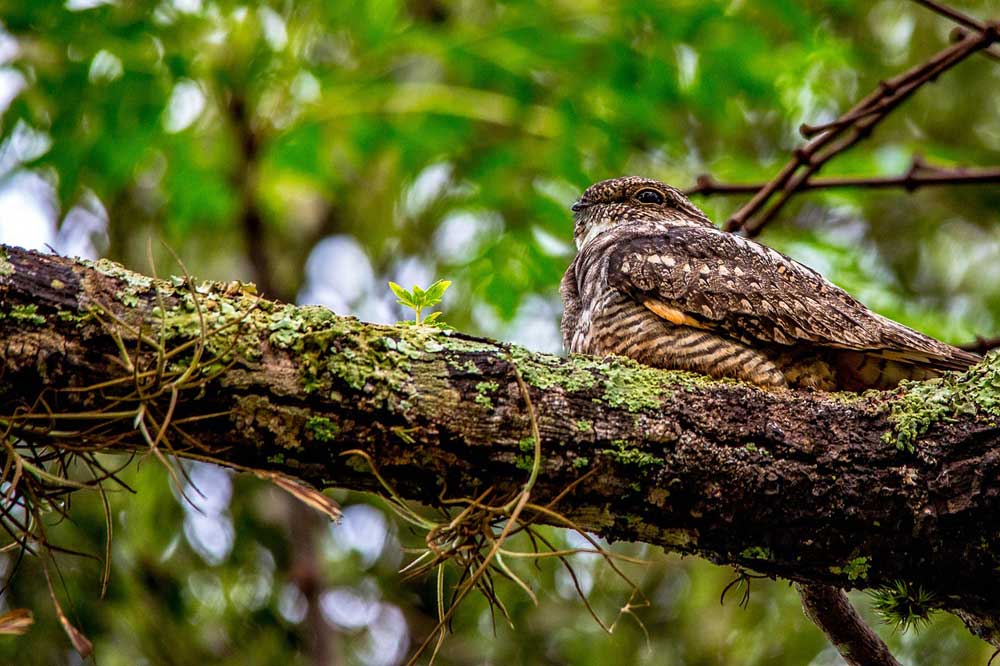Bob Humphrey
Long before the first turkey gobbles or the barred owl hoots, the pre-dawn spring air rings with the iconic call of a night bird, repeatedly chanting its name, whip-poor-will, whip-poor-will. Even its scientific name, Antrostomus vociferus intimates its vehement vocalizations. Once a common call in the turkey woods, it’s now becoming a rare treat.

Description
This medium-sized member of the nightjar family is cryptically colored with mottled grey, black and brown plumage that helps it blend in with its preferred forest floor habitat. Males sport a white patch below their black throat, and white tips on their outer tail feathers. Females are similar, except the white parts are light brown. The bill is short and black but opens into a wide, gaping mouth when feeding. Males may repeat their nominate call for hours to defend their territory and attract a mate, mostly after the sun sets and before it rises. They also have large eyes to better see at night.
- Average length: 8-1/2 - 10-1/2 in.
- Average wingspan: 17-1/2 - 19-1/2 in.
- Average weight: 1-1/2 - 2-7/16 oz.
Breeding
Much like another nocturnal suitor, the woodcock, males approach females on ground with a head-bobbing, bowing and sidling display. They nest on the ground, commonly laying 2 eggs at a time in a rudimentary bowl scraped in dead leaves on the forest floor. Once incubating, females seldom leave the nest except to feed or if disturbed. Whips time their laying with the lunar cycle so that young hatch in about 3 weeks, on average around 10 days before the full moon, after which both adults care for and feed them by regurgitating insects.
Feeding Habits
Not truly nocturnal, whips begin feeding around 30 minutes after sunset and continue as long as there is sufficient light. They may feed all night during full moon periods, or far less under dense cloud cover or periods of cold, wet weather. They resume feeding 30 or 40 minutes before sunrise and continue until daylight. Whips are insectivores, taking flight to catch flying insects on the wing by opening a mouth that allows them to swallow insects up to 2 inches long. They also sometimes forage on rotten logs and the ground for insects, worms and caterpillars.
Distribution & Population
Breeding range includes most of the eastern U.S. and maritime Canada, parts of the southwest including southern Arizona and New Mexico, west Texas and Mexico. Whips winter in Florida and along the Gulf Coast.
This iconic and once abundant species has declined significantly - by about 60% since 1966. In 2017, the species was uplisted from least concern to near threatened on the IUCN Red List. Reasons for the decline include decreased forest disturbance and early successional forest habitat, pesticides and intensified agriculture, the latter two of which have caused declines in flying forage.
Legend and Lore
Native Americans considered the whip’s song to be a death omen, and New England legend says the birds can sense a departing soul and capture it as it flees. Its incessant call has also been the sub-plot to many tales involving insomnia and the resulting madness.
Conservation and Management
Efforts are underway to reverse the declining trend. One such effort is the Central Hardwoods Joint Venture (CHJV), a partnership of state, federal and non-for-profit wildlife conservation agencies and organizations. Scientists are taking a closer look at the reasons for declines of whips and other species, and developing management recommendations.




























